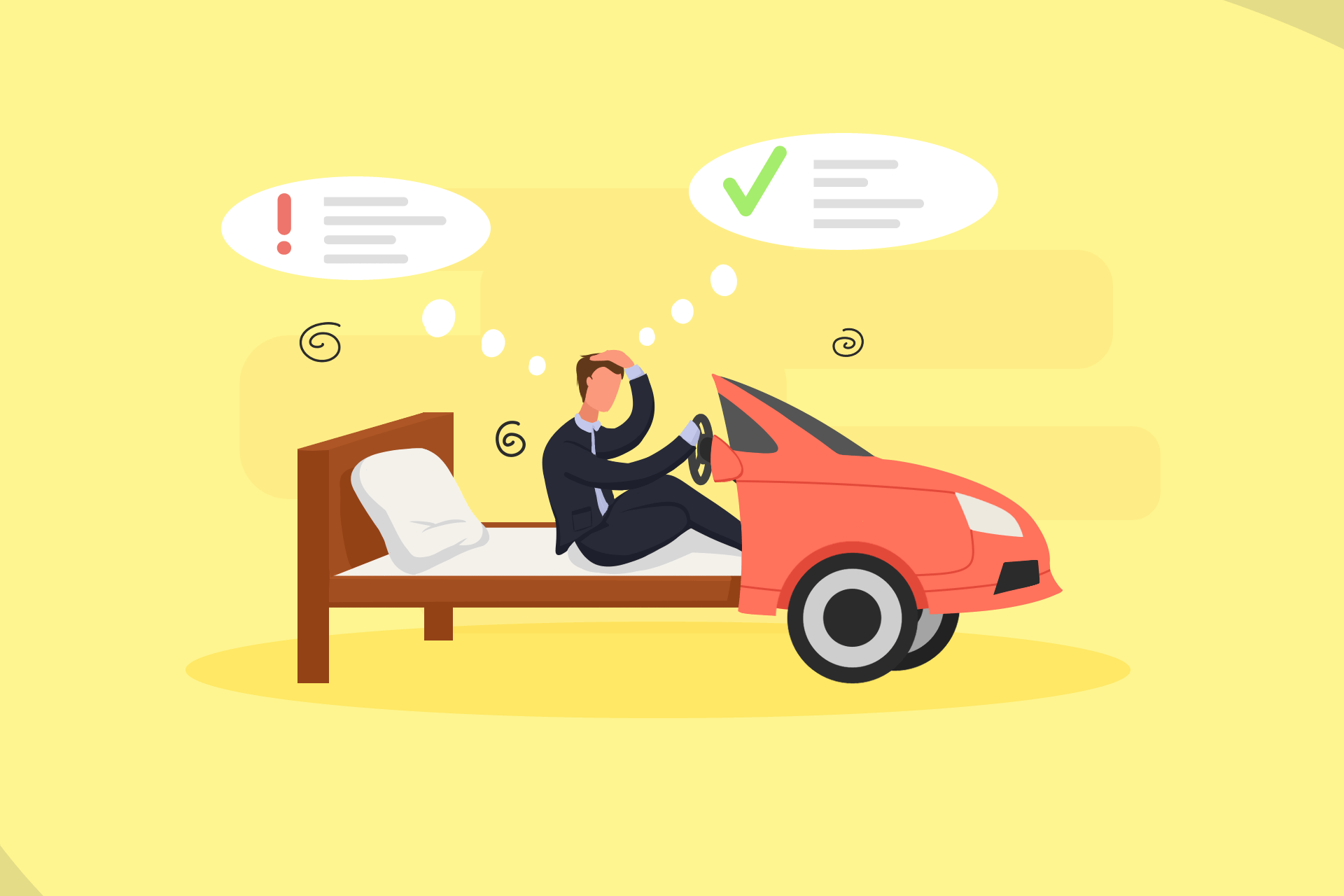Narcolepsy, a neurological condition characterized by a disruption in the regulation of sleep-wake cycles, casts a unique shadow on the lives of those who grapple with it. It challenges the fundamental rhythm that governs our daily existence, oscillating between wakefulness and slumber, often with perplexing consequences. The big question is: “Can people with narcolepsy drive? And will I be allowed to drive a vehicle if I’m diagnosed with narcolepsy?” Well, for someone who lives with narcolepsy, driving can be a challenging and potentially dangerous task.
This comprehensive guide explores the risks associated with driving when you have narcolepsy. It also explores legal considerations, meds to enhance safety, and practical tips to navigate the road with confidence, empowering you to navigate the road confidently while ensuring the safety of all.
What Is Narcolepsy?
Narcolepsy is a chronic and lifelong neurological condition that impacts the brain’s capability to regulate sleep-wake patterns. It is a relatively rare condition, with an estimated prevalence of around 1 in 2000 people, and it often emerges during juvenility or young adulthood. According to the National Institute of Neurological Disorders and Strokes, it’s estimated that approx. 125,000 to 200,000 individuals in the U.S. are living with narcolepsy. Other statistics suggest that the prevalence of the disorder in the USA is approx. 44.3 to 50 individuals per 100,000 [1].
The precise count of individuals affected by narcolepsy can be challenging to ascertain. Experts point out that many cases may go undiagnosed or unreported. It’s necessary to note that these estimates may be conservative since they only take into account individuals with insurance who actively sought medical care, potentially excluding certain segments of the population. The number of people with narcolepsy may also vary by geographical location. For instance, a study conducted in 2022 found that approx. 47 individuals per 100,000 in Europe were estimated to have narcolepsy. Nonetheless, in Germany, the incidence was roughly 17.88 people per 100,000 [1].
The precise causality of narcolepsy isn’t exhaustively understood, but it’s acknowledged to involve a mix of genetic and environmental facets. Researchers have identified a link between specific genes and an autoimmune response that targets cells responsible for regulating wakefulness. Some cases of narcolepsy are associated with a deficiency of a neurotransmitter called hypocretin (also comprehended as orexin), which plays a crucial role in maintaining wakefulness [2]. On certain occasions, individuals may undergo narcolepsy unrelated to diminished hypocretin levels, and in such instances, the underlying cause of the condition may remain unidentified.
It’s important to note that narcolepsy is a chronic condition, but its symptoms can often be managed effectively with lifestyle adjustments, medication, and support. People with narcolepsy can lead fulfilling lives by working closely with healthcare professionals to develop a tailored management plan that addresses their specific needs and symptoms.
What Are the Risks of Narcolepsy While Driving?
Narcolepsy manifests through a range of symptoms, including excessive daytime sleepiness (EDS), cataplexy, hallucinations, and sleep paralysis. Certainly, EDS is the hallmark symptom of narcolepsy. Individuals with this condition experience an overwhelming & persistent desire to sleep during the day, often at inappropriate times. This constant drowsiness can interfere with daily activities, including school, work, & social interactions. Indeed, the mentioned symptoms, often abrupt and unpredictable, can profoundly affect your capacity to drive safely. Let’s further discuss the risks of narcolepsy while driving in detail:
Drowsy Driving
Driving necessitates swift reactions, such as the ability to promptly apply brakes or steer in response to sudden stops by the vehicle in front of an unexpected animal on the road. Nonetheless, when drowsiness sets in, your reaction time becomes sluggish, and your attentiveness to the road may significantly diminish. Drowsy driving entails the act of operating a vehicle while experiencing sleepiness or fatigue. It’s a grave concern for individuals living with narcolepsy.
The hallmark symptom of narcolepsy, EDS, results in an overwhelming and persistent urge to sleep during the day [3]. This profound sleepiness can strike suddenly and unpredictably, making individuals with narcolepsy highly susceptible to falling asleep while behind the wheel. Such episodes can lead to impaired judgment, decreased reaction times, inability to pay proper attention to the road, and a significantly increased risk of accidents.
According to a CDC study, drowsy driving contributed to 91,000 accidents in 2017, leading to around 50,000 injuries and almost 800 fatalities. In 2020, official police reports documented 633 deaths attributable to drowsy driving. Nevertheless, it is important to note that these figures represent underestimations, and it is possible that more than 6,000 fatal accidents annually may be associated with drowsy drivers [4].
Still, the dangers of drowsy driving are not to be underestimated, and individuals with narcolepsy must be vigilant about their condition’s potential to compromise their safety on the road.
Sleep Attacks
Sleep attacks are another characteristic symptom of narcolepsy and represent a particularly hazardous risk while driving. These attacks are characterized by an irresistible and overwhelming urge to fall asleep, and without warning [5]. Unlike normal fatigue, sleep attacks are abrupt and uncontrollable. This means that a person with narcolepsy will be able to experience a sleep attack at any moment and in any situation, whether you’re engaged in conversation, driving, or having a meal. There may not always be a clear and intense feeling of sleepiness as a prior warning. The sudden onset of a sleep attack can result in a catastrophic loss of control over the vehicle, posing a severe danger to both the driver and others on the road. Given the potential consequences, individuals with narcolepsy must recognize the gravity of this risk and take necessary precautions.
Sleep Paralysis
Sleep paralysis is yet another unsettling symptom of narcolepsy that can jeopardize safe driving. It involves a temporary inability to move or speak when falling asleep or waking up. While not directly linked to driving itself, the experience of sleep paralysis can be terrifying and disorienting.
It is important to differentiate sleep paralysis from cataplexy, as the former typically happens during these transitional moments, while positive emotions often trigger the latter. If you have narcolepsy and encounter sleep paralysis while driving, it could create a hazardous situation on the road. You may become immobilized and unable to control the vehicle, increasing the risk of accidents. Consequently, while driving with narcolepsy, you should be aware of the potential for sleep paralysis and take steps to minimize its impact on your ability to drive safely.
Cataplexy
Cataplexy, closely associated with narcolepsy, is the premature loss of muscle tone activated by powerful emotions. While driving, a cataplectic episode can lead to a loss of control over the vehicle. Such episodes may manifest as weakness in your legs, slurred speech, or even complete physical collapse. The unpredictable nature of cataplexy makes it a significant risk for you as a driver with narcolepsy. Accidents can occur when a cataplectic episode interferes with your ability to operate a vehicle, potentially causing harm to both yourself and others on the road. Managing cataplexy becomes essential in ensuring your safety while driving. It’s important to note that not all people with narcolepsy experience cataplexy. Cataplexy is emotionally activated temporary muscle weakness. Most attacks are initiated by powerful, typically positive emotions, such as joking, laughter, or excitement. However, anger or despair can also activate these episodes in some people, making it crucial to be aware of your emotional triggers and take appropriate precautions while driving.
Furthermore, it’s essential to consider the impact of two other common symptoms of narcolepsy. Hypnagogic and hypnopompic hallucinations are vivid and often frightening dream-like experiences that can occur when falling asleep (hypnagogic) or waking up (hypnopompic). These hallucinations, while not directly related to driving, can contribute to the confusion and fear associated with sleep paralysis, potentially compounding the risks associated with this symptom. Additionally, a significant number of people diagnosed with narcolepsy encounter disturbances in their nightly sleep routines, which are marked by recurrent awakenings throughout the night. This fragmented sleep leads to fatigue, which, in turn, results in a heightened reliance on daytime naps to combat sleepiness. Unfortunately, fragmented sleep can negatively impact your ability to stay alert while driving, as ongoing fatigue and sleep deficits make it more challenging to focus and make sound judgments.
Is It Legal to Drive with Diagnosed Narcolepsy?
Indeed, you can drive with narcolepsy, but is it safe? Well, above all, safety is of paramount concern. Your ability to operate a vehicle should encompass being medically fit, ensuring that you can remain alert while driving.
The National Highway Traffic Safety Administration (NHTSA), the federal agency responsible for highway safety, advises that individuals with narcolepsy should engage in driving only if they are under a treatment regimen that effectively maintains their wakefulness.
It’s important to note that driving regulations differ across states. In most states, during the driver’s license application process, you are encouraged to voluntarily disclose any medical conditions that could potentially impact your driving capabilities. Nevertheless, there are a handful of states where certain rules apply. For example, states such as California and Pennsylvania mandate the reporting of conditions like narcolepsy, specifically addressing concerns regarding their potential impact on your ability to drive safely.
Drugs That Make Driving with Narcolepsy Safer
Several medications can aid in the management of narcolepsy symptoms, making driving a safer endeavor for those affected. These may encompass stimulants like modafinil (Provigil), armodafinil (Nuvigil), sodium oxybate (Xyrem), pitolisant (Wakix), and stimulant drugs (Concerta, Adderall, Ritalin, and others) that enhances nighttime sleep quality and reduce daytime sleepiness. It’s possible to legally obtain these meds for a medical reason with a prescription, and taking them might make it more noncontroversial to drive & lessen your risk of an accident.
As a note, using these meds may enhance driving safety and lower the chances of an accident. However, it’s important to acknowledge that no medication guarantees complete accident prevention or sustained alertness while driving. When prescribed narcolepsy meds by your healthcare provider, inquire about how they might impact your driving capabilities and their possible side effects. This is particularly helpful if you are driving where there are a lot of cars or on a road where attention is paramount.
According to the U.S. Food and Drug Administration (FDA), some prescription and nonprescription meds, including modafinil & armodafinil, can have side effects and cause reactions that may make it unsafe to drive. Negative effects can include sleepiness/drowsiness, dizziness, blurred vision, slowed movement, fainting, ineptitude to focus or pay attention, and excitability [6]. It is recommended that until an individual knows how modafinil affects them, they may not drive, use machinery, or do any activity that requires mental alertness [7].
In a 2019 study, a small group of individuals with narcolepsy, as well as those with another sleep disorder known as idiopathic hypersomnia, were subjected to real and simulated driving assessments. The findings revealed that participants who received a 400-milligram dose of modafinil demonstrated improved performance in their simulated driving tests compared to those who were administered a placebo [8].
Other Tips That May Help
In addition to medication, various lifestyle changes and strategies can assist you with narcolepsy in driving more safely [9][4]:
- avoid driving during times when you typically feel tired, such as late at night or early in the morning;
- refrain from driving right after consuming a substantial meal;
- steer clear of driving after drinking alcohol or taking meds that induce drowsiness, such as anti-anxiety drugs or antihistamines;
- consider taking a short nap before hitting the road to reduce the risk of narcoleptic episodes while driving;
- if embarking on a long journey, plan breaks for short naps or share the driving with a companion;
- if you experience cataplexy, avoid activities before driving that might evoke strong emotions, laughter, or other triggers for cataplexy episodes;
- be cautious about common “life hacks” like chewing gum, adjusting radio volume, using air conditioning, or opening windows to stay awake. These actions can be distracting and potentially increase the risk of an accident.
Besides, keep an eye out for signs that you might be falling asleep at the wheel, including nodding your head, drooping eyelids, daydreaming, frequent blinking, or difficulty recalling the last few miles driven. If you experience any of these signs, pull over before succumbing to sleep.
So, Can People with Narcolepsy Drive?
In conclusion, people with narcolepsy can indeed drive, but it requires meticulous management of their condition and adherence to safety guidelines. Regular communication with a physician, the use of appropriate meds, and the implementation of lifestyle changes, including avoiding driving when tired or after consuming certain substances, can significantly reduce the risks associated with driving while living with narcolepsy. Prioritizing safety, not only for yourself but also for others on the road, is paramount when navigating the challenges of narcolepsy and driving.
References
- What is the prevalence of narcolepsy? By Jenna Fletcher. Published: January 31, 2023. Medically reviewed by Nick Villalobos. Medicalnewstoday.com.
- Narcolepsy. Retrieved: November 2, 2023. Nhlbi.nih.gov.
- Therapeutic Strategies for Mitigating Driving Risk in Patients with Narcolepsy. By Catherine A McCall and Nathaniel F Watson. Published: November 12, 2020. Ncbi.nlm.nih.gov.
- Drowsy Driving: Asleep at the Wheel. Retrieved: November 2, 2023. Cdc.gov.
- Sleep Attacks: What You Should Know. By Danny Bonvissuto. Published: March 16, 2023. Medically reviewed by Minesh Khatri. Webmd.com.
- Some Medicines and Driving Don’t Mix. Published: March 9, 2021. Fda.gov.
- Can CMV drivers be qualified while being prescribed Provigil (Modafinil)? Retrieved: November 2, 2023. Fmcsa.dot.gov.
- Maintenance of Wakefulness Test, real and simulated driving in patients with narcolepsy/hypersomnia. By Patricia Sagaspe, Jean-Arthur Micoulaud-Franchi, Olivier Coste, et al. Published: March 8, 2018. Pubmed.ncbi.nlm.nih.gov.
- Therapeutic Strategies for Mitigating Driving Risk in Patients with Narcolepsy. By Catherine A McCall and Nathaniel F Watson. Published: November 12, 2020. Ncbi.nlm.nih.gov.








